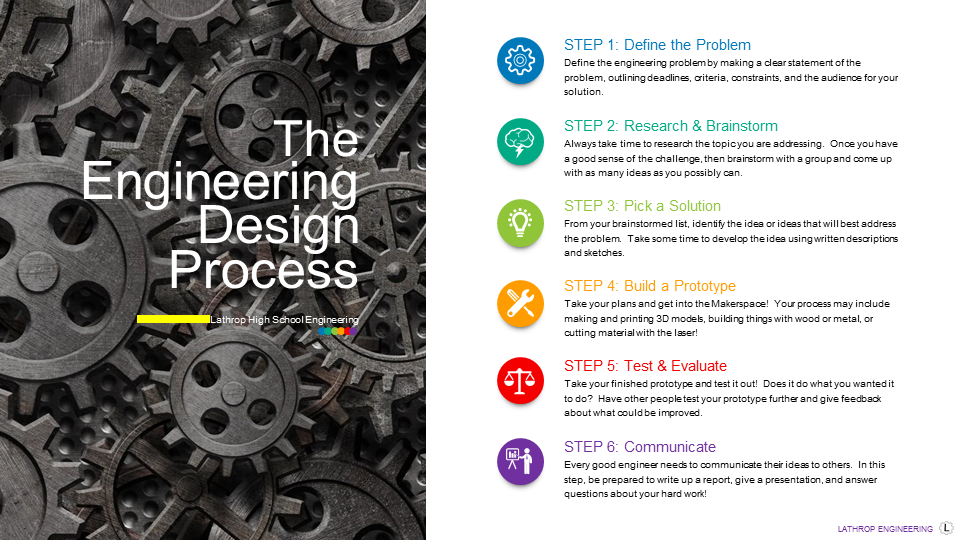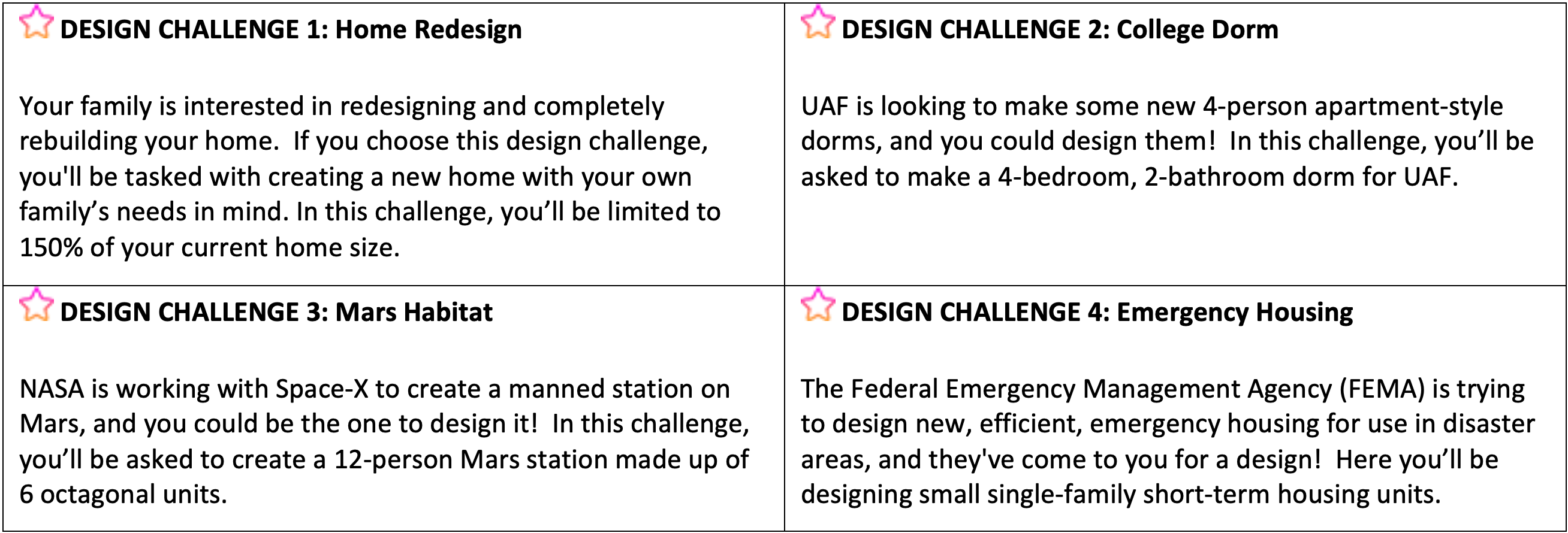Welcome to the 5th unit of Civil Engineering & Architecture! At this point, you’ve seen all the main ideas that residential housing design focuses on. You’ve looked at the ideas of planning around a user’s needs, creating basic things in Revit, adding details in Revit, and getting a picture for the larger site all within the computer! Specifically, this semester you’ve covered:
- The design brief and determining home owner needs
- Bubble diagrams
- Revit: walls, doors, windows, floors, roofs
- Revit: foundations, furniture, electrical
- Revit: plumbing, waste water, site plans
Now we get to bring it all together as you join Lathrop’s architecture & design firm “Lathrop Design: Architecture Studio”! As an architect for Lathrop Design, you’ve been asked to come up with a complete design to meet one of four specific residential design challenges. You can choose from:
- Home Redesign: redesign your own home
- College Dorm: create a 4-person apartment style dorm
- Mars Habitat: create a multi-octagonal Mars habitat
- Emergency Housing: create efficient emergency shelters!
Whichever design challenge you choose, you’ll need all your design tools at the ready as we spend Units 5 & 6 meeting the challenge and representing our work!
The first part of our unit is all about the user needs and basic designs in Revit. Start by watching the three presentations linked below just to give you some new ideas. Then review the four design challenge options you have available. Complete details of each design challenge are provided in your Unit 5 handout. Once you’ve chosen a challenge, do some brainstorming and create at least 2 very different layouts using bubble diagrams. Once you’ve settled on your design, start working in Revit to put together walls, floors, ceilings, roofs, windows, and doors! Pay particularly close attention to the details of the design challenge – you need to make sure you meet each of the criteria!
GRADING & PROCESS
![]() Watch the three videos below on and take a full page of notes on the ideas you see presented and on any cool new ideas you have while watching
Watch the three videos below on and take a full page of notes on the ideas you see presented and on any cool new ideas you have while watching
![]() Select one of the four residential design challenges – details are listed in hour Unit 5 rubric
Select one of the four residential design challenges – details are listed in hour Unit 5 rubric
![]() Create at least 2 distrinct bubble diagrams as you brainstorm possible layouts for your design.
Create at least 2 distrinct bubble diagrams as you brainstorm possible layouts for your design.
![]() Get into Revit and complete the beginnings of your design to include: walls, floors, ceilings, roof, windows, and doors.
Get into Revit and complete the beginnings of your design to include: walls, floors, ceilings, roof, windows, and doors.
Architecture Design
Residential Roof Types
Design Ideas
Real civil engineers and architects use Revit as a design tool to make real-world plans for homes and buildings of all kinds. This part of the unit is meant to give you a chance to really dig in to some of the key parts of Revit like walls, doors, windows, floors, roofs, etc. Here you’ll plan and design a small utility shed in Revit. As you work through this part of the unit, take good notes because you’ll use the same tools and procedures to design full houses in our upcoming projects!
Also make sure to take the Unit 2 Quiz by the due date!
GRADING & PROCESS
![]() Review the Utility Shed Construction Example presentation and take some notes on what needs to go into it. Then, continue taking notes and learning Revit as you start your Utility Shed project and watch the four Utility Shed in Revit videos.
Review the Utility Shed Construction Example presentation and take some notes on what needs to go into it. Then, continue taking notes and learning Revit as you start your Utility Shed project and watch the four Utility Shed in Revit videos.
![]() Follow the paraemeters in your handout to create a Utility Shed in Revit. Read the nine parameters and make sure that your design fits all the criteria.
Follow the paraemeters in your handout to create a Utility Shed in Revit. Read the nine parameters and make sure that your design fits all the criteria.
![]() Take the Unit 2 Quiz before September 20!
Take the Unit 2 Quiz before September 20!
![]() Have Mr. Benshoof check-off your complete Revit model
Have Mr. Benshoof check-off your complete Revit model
Plumbing Ideas 1
Plumbing Ideas 2
Elecrtical Ideas 1
Electrical Ideas 2

Engineering Design Process Overview
The final step to completing the engineering design process is to share your work with other people and evaluate your potential success. As we finish this up, you’ll load your mini-essays into the Arctic innovation Challenge website. Then you’ll learn about what a decision matrix is and create one to evaluate your own idea. Have two classmates not from your design team evaluate your idea and record their feedback. Then, have each person in your design team create an Autodesk model of what your product will look like.
GRADING & PROCESS
![]() Upload your responses to the Arctic Innovation Design Competition website in the Junior Division!
Upload your responses to the Arctic Innovation Design Competition website in the Junior Division!
![]() Create an evaluation matrix in your engineering notebook to evaluate the success of your product
Create an evaluation matrix in your engineering notebook to evaluate the success of your product
![]() Find two people that aren’t in your design group to evaluate your idea using your evaluation matrix. Record their feedback in your engineering notebook.
Find two people that aren’t in your design group to evaluate your idea using your evaluation matrix. Record their feedback in your engineering notebook.
![]() Create an Autodesk model of your proposed solution. Each person in your group should make their own model – they might not all be exactly the same, and that’s okay.
Create an Autodesk model of your proposed solution. Each person in your group should make their own model – they might not all be exactly the same, and that’s okay.
Concrete Pad Estimation
Heat Loss & Gain
Part 1 Resources
Part 2 Resources
